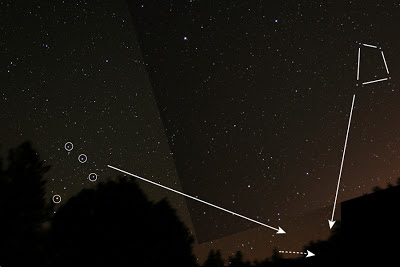From our position in the solar system, Omega Centauri is the brightest of the globular clusters, which are dense packs of gravitationally bound stars forming clusters that are billions of years old. Some theories suggest that globular clusters are remnants of galaxies that have been eaten by our own.
Omega Centauri is best seen from the Southern Hemisphere, but in May, obervers at low lattitudes of the Northern Hemisphere get a glimpse of it skirting the southern horizon. The following photos show Omega Centauri in a gap of trees on my southern horizon.
Omega Centauri emerging from one tree and going behind the next.
(80 seconds, F4, 400 ISO, 70 mm focal length)
After adjusting the camera (during which Omega Centauri moved noticably) I resumed tracking of the object through the gap in the trees. (120 second, F4, 400 ISO, 70mm focal length)
Last best exposure before I lost it in the trees. (120 second, F4, 400 ISO, 70mm focal length)
These photos were taken at 10:43, 10:53, and 10:56 PM, when Omega Centauri was due south. I highly recommend that anyone with a low southern horizon look for this object now with binoculars or a small telescope. In general, any object appears two hours earlier the following month, so this weekend, Omega Centauri, it should be due south at approximately 10:30 pm.
Find Omega Centauri's general region by using corvus (right in the image below) as a pointer. Depending on the clearance of your horizon, you may also see scorpius in an upright position (left).
The dotted line shows the path of Omega Centauri. Scorpius on the left and Corvus on the right can be used to find the general location.





No comments:
Post a Comment